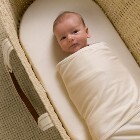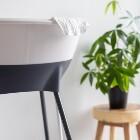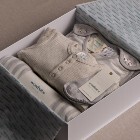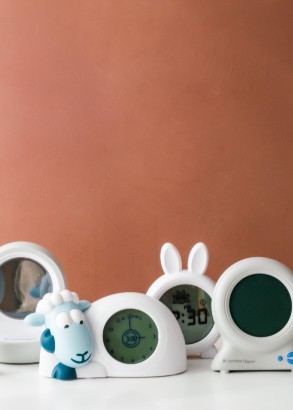Children waking too early in the morning is a problem for the whole family. When children don’t get enough sleep overnight, they will be grumpy during the day. And when parents get woken up too early....it is harder to cope with grizzly children! Unless you take action to teach your children to sleep in later in the morning, this vicious cycle can become a very firm habit.
Choosing & Using a Sleep Trainer Clock
Reasons for early waking & what to do about it
-
They have been asleep for long enough - for example their bedtime is 5-6pm, so they are ready to get up by 5-6am - Move their bedtime later, 7pm is perfect.
-
They are cold - Use a winter weight sleeping bag, add merino clothing or use a sleepsuit.
-
They are disturbed by inside or outside noises such as birds, dogs, traffic, parent getting up for work - Use white noise on repeat all night.
-
ALL children wake at around 5-5.30am as they move into the last sleep cycle of the night. They ‘sleep through’ till 7am when they have learned to go back to sleep at this time. Parental behaviour is usually what tells a child if it is morning or not (e.g. letting child in your bed) - Be consistent with your behaviour and use a sleep trainer clock!
How does a sleep trainer clock help?
-
Children don't know that time it is...they can’t tell the time from a regular clock and their body clock could be telling them it's morning at 5am!
-
A sleep trainer clock uses a simple visual change to show when it is ‘morning’ and therefore when your child is allowed out of bed.
-
Before this change happens, the clock shows it is still night time and therefore your child should be in bed asleep (or at least quiet and not disturbing the rest of the family)
-
The clock is objective and can’t be argued with...it is either 'morning' or it is not.
-
Using a sleep trainer clock becomes an essential part of your bedtime routine – putting the clock ‘to sleep’ and saying you will see it wake up in the morning reinforces the message about staying in bed both at night time and in the morning.
How can the child tell it is morning?
It depends on the clock. With the Gro Clock, the stars display on the screen countdown and change the moon's face on a blue coloured screen to a smiling sun on a yellow background. For the Yogasleep Light to Rise, the colour changes and dims before sleep and colour cues for wake-up time. The chart below has details of how each clock "wakes up" with more detail on each product page.
What age can I introduce a Sleep Trainer clock?
It depends a lot on the child but generally from about 2 years old. The key is when your child is able to understand what the clock means - for example, if the moon is out or the stars are showing on the clock's display, that means stay in bed. Or when your child can tell the clock being green or the sun coming up means the day has started. These clocks can be used as a nightlight from newborn so you'll have a trainer clock ready for when your little one is old enough to understand it.
What's the difference between the original Groclock and the USB Groclock?
The new USB Groclock features a USB cable rather than a traditional mains power plug. The Cable is compatiable with most USB plugs used as phone chargers.
Choosing which sleep trainer to buy
As with most things electrical, there is a strong element of ‘you get what you pay for’ and budget is always a factor. A sleep trainer clock is something you want to get a lot of worry free use out of. Only the sleep trainer clocks that meet our quality standards feature in our range.
When considering which clock to get think about which clock you like and your child likes the look of as well as if you'll use it away from home. Sleep trainer clocks with a battery back-up are good options for when there's a power outage or when you're away from home as you don't need to worry about remembering the plug.
Some sleep trainer clocks, such as the Yogasleep Light to Rise have additional features such as sound machine and night light, which is great for space-saving and budget.
Gro Clock by Gro Company
Now made by Tommee Tippee, the makers of grobags, the gro clock is the top of the range. It is fantastic quality, with a great range of features. The backlit display shows stars which gradually go out over the duration of the sleep time, making it easy to judge 'how long till morning'. When it's time to wake the display colour changes and the moon changes to a picture of a sun.
-
Mains powered
-
Can have digital clock on or off
-
Can be used as a nightlight since it runs on power and it has 10 levels of brightness from no light to a bright blue glow.
-
Optional audio alarm
- Can stand on a chest of draws
-
Can set different time for morning and naptime (or weekend) wake up.
-
Comes with a small story book to reinforce the 'stay in bed till the sun comes up' message.
-
A simple, smart-looking clock that your child could continue to use as a regular alarm clock as they get older.
Light to Rise by Yogasleep
Made by Yogasleep, well-known for their sound machines, the Light to Rise is another top-of-the-range trainer clock, with the additional features of a sound machine and night light. It uses changing colours to cue sleep and wake-up.
-
Mains powered
-
Can create custom sleep schedules for morning and nighttime
-
Can be used as a nightlight with 8 colour choices and 4 brightness levels.
- Can stand on a chest of draws
-
Sound machine which offers 30 relaxing sounds (brown, white and pink noise) with volume control.
-
A modern, multi-purpose sleep trainer, all in one.
Sleep Trainer Clock Comparison Chart
| USB Groclock Sleep Trainer Clock | Light to Rise Sleep Trainer, Sound Machine & Night Light | Sam the Lamb Sleep Trainer | Sleep Trainer Bunny Clock | |
| Brand | Tommee Tippee | Yogasleep | Zazu | Oricom |
| Visual wake up clues | Yes - blue face & stars for sleep and yellow face with sun for wake. Stars countdown during the night to show passing of time. | Yes - yellow light turns on dimly 30 minutes before wake up time and gradually gets brighter. Light turns to green at wake up time. | Yes - eyes closed for sleep and open for wake. Stars to countdown end of bedtime. Red display for sleep. Orange display to show wake up time is approaching. Green display & eyes open for wake up time. | Yes - blue face with moon for night time and yellow face with sun for daytime |
| Daytime & Night time settings. | Yes | Yes | 1 set sleep time, plus a Naptimer which can be manually set from 3-180 minutes. | Set one time for sleep only. |
| How many wake-up times can be set? | 2 (eg weekday and weekend) | 1 | 1 | 1 |
| Alarm | 2 clock settings with audible alarm | No | Yes, with 3 sounds & adjustable volume | Yes, with audible alarm |
| Can change Sounds | Yes - 30 sounds including brown noise, white noise, pink noise, fan sounds, nature sounds and lullabies. | Yes - 3 alarm sounds w/ adjustable volume | ||
| Can change brightness | | | | |
| Clock face dims for sleep | | | | |
| Can turn clock face off at sleep time. | | | ||
| Can set sleep time | | Yes - set time easily on the device | Yes and you can also turn sleep time on manually. | |
| Can change display colour | No | Yes, multicolour night light | No | No |
| Childlock | | No | | |
| Demo Mode | | No | | |
| Digital or analogue display | Digital | Digital | Both | Digital |
| Mains or Battery operated | Mains - USB cable.
Has a "power-cut recovery" feature to remember the time even if there's a power cut. | Mains - USB cable.
Has a button battery to keep the settings in the event of a power cut. Please see the product page for safety information. | Both - 4 x AA alkaline batteries or USB cable. Recommended to use batteries as a back up in case of powercut. Clock will use power first with batteries as back up. | Battery powered with USB charging cable included. |
| Rechargeable | No | No | No | Yes with USB cable. Approx 2-3 hours to charge. |
Top Tips When Introducing a Sleep Trainer Clock
The effectiveness of a sleep trainer clock depends very much on your child’s age and development. Your child will need to grasp the concept of waiting for the clock to change colour and be expected to stay in bed until that time. It usually works well with children from 2 years of age. If your child can follow simple instructions such as; ‘Find me your shoes, or turn the light off, they are likely to be ready.
Here are some simple but important steps to follow to get the most out of your clock.
• Make sure you explain fully to your child what is expected of them. Use the demo function on the clock to show your child a sample of the bedtime function and how the clock works.
• Adjust the brightness of the screen to suit your child’s room. If it’s too bright it may be too distracting and keep your child awake unnecessarily during the night.
• Place the clock either by your child’s bed or high up on a shelf to stop your child from playing with it and always use the clock in ‘key-lock’ mode to prevent them from adjusting the time.
• Set the clock to come on close to your child’s usual wake up time to start with. For example, if your child usually wakes around 5:30am but you would prefer them to wake at 6:30am, set the clock to come on around 5:40am to start with. When your child wakes at their usual time of 5:30am, pop in briefly and tell them it’s night-time and they must stay in bed until the screen changes colour. After a few days you can gradually adjust the time but don’t rush this process. For best results, move the time forward by 15 mins every 7-10 days until you reach the desired time. NB: It can take up to 4-6 weeks to adjust your child’s wake up time by 1 hour.
• Treat any waking before your designated morning time the same as you would night waking. So if you wouldn’t let your toddler out of bed at 2am, then don’t do it at 5am!
• Make sure your child isn’t having too much day sleep or a nap too early in the day as this is likely to contribute to early rising. Most toddlers between 2-2 ½ years need approx. 45-90 mins of day sleep.
• The clock can be used effectively for daytime naps too and is particularly great if you just want your child to have quiet time in their room.
• Introduce a reward chart to help encourage your child stay in bed until the desired time. Explain that they will receive a prize after a certain number of nights and be as clear and consistent as possible. Make the rewards simple and desirable such as a small car, colouring book, pop up book etc.
Rewards Charts to Help Your Child Stay in Bed
Star or sticker charts are a reward system to encourage desired behaviour changes. It can also help reverse negative emphasis on early waking. Rewards charts can help change the behaviours that can have an influence on early waking but not always. Rewards should be used with lots of praise smiles and hugs. Sometimes a positive comment e.g. “I like the way you stayed in bed today” combined with a hug is all that is required.
Download our selection of rewards charts and certificates here.
SLEEP TRAINER CLOCKS

























